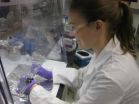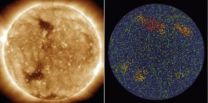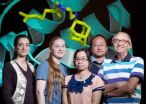(Press-News.org) Ancient Earth might have had an extraterrestrial supply of vitamin B3 delivered by carbon-rich meteorites, according to a new analysis by NASA-funded researchers. The result supports a theory that the origin of life may have been assisted by a supply of key molecules created in space and brought to Earth by comet and meteor impacts.
"It is always difficult to put a value on the connection between meteorites and the origin of life; for example, earlier work has shown that vitamin B3 could have been produced non-biologically on ancient Earth, but it's possible that an added source of vitamin B3 could have been helpful," said Karen Smith of Pennsylvania State University in University Park, Pa. "Vitamin B3, also called nicotinic acid or niacin, is a precursor to NAD (nicotinamide adenine dinucleotide), which is essential to metabolism and likely very ancient in origin." Smith is lead author of a paper on this research, along with co-authors from NASA's Goddard Space Flight Center in Greenbelt, Md., now available online in the journal Geochimica et Cosmochimica Acta.
This is not the first time vitamin B3 has been found in meteorites. In 2001 a team led by Sandra Pizzarello of Arizona State University, in Tempe discovered it along with related molecules called pyridine carboxylic acids in the Tagish Lake meteorite.
In the new work at Goddard's Astrobiology Analytical Laboratory, Smith and her team analyzed samples from eight different carbon-rich meteorites, called "CM-2 type carbonaceous chondrites" and found vitamin B3 at levels ranging from about 30 to 600 parts-per-billion. They also found other pyridine carboxylic acids at similar concentrations and, for the first time, found pyridine dicarboxylic acids.
"We discovered a pattern – less vitamin B3 (and other pyridine carboxylic acids) was found in meteorites that came from asteroids that were more altered by liquid water. One possibility may be that these molecules were destroyed during the prolonged contact with liquid water," said Smith. "We also performed preliminary laboratory experiments simulating conditions in interstellar space and showed that the synthesis of vitamin B3 and other pyridine carboxylic acids might be possible on ice grains."
Scientists think the solar system formed when a dense cloud of gas, dust, and ice grains collapsed under its own gravity. Clumps of dust and ice aggregated into comets and asteroids, some of which collided together to form moon-sized objects or planetesimals, and some of those eventually merged to become planets.
Space is filled with radiation from nearby stars as well as from violent events in deep space like exploding stars and black holes devouring matter. This radiation could have powered chemical reactions in the cloud (nebula) that formed the solar system, and some of those reactions may have produced biologically important molecules like vitamin B3.
Asteroids and comets are considered more or less pristine remnants from our solar system's formation, and many meteorites are prized samples from asteroids that happen to be conveniently delivered to Earth. However, some asteroids are less pristine than others. Asteroids can be altered shortly after they form by chemical reactions in liquid water. As they grow, asteroids incorporate radioactive material present in the solar system nebula. If enough radioactive material accumulates in an asteroid, the heat produced as it decays will be sufficient to melt ice inside the asteroid. Researchers can determine how much an asteroid was altered by water by examining chemical and mineralogical signatures of water alteration in meteorites from those asteroids.
When asteroids collide with meteoroids or other asteroids, pieces break off and some of them eventually make their way to Earth as meteorites. Although meteorites are valued samples from asteroids, they are rarely recovered immediately after they fall to Earth. This leaves them vulnerable to contamination from terrestrial chemistry and life.
The team doubts the vitamin B3 and other molecules found in their meteorites came from terrestrial life for two reasons. First, the vitamin B3 was found along with its structural isomers – related molecules that have the same chemical formula but whose atoms are attached in a different order. These other molecules aren't used by life. Non-biological chemistry tends to produce a wide variety of molecules -- basically everything permitted by the materials and conditions present -- but life makes only the molecules it needs. If contamination from terrestrial life was the source of the vitamin B3 in the meteorites, then only the vitamin should have been found, not the other, related molecules.
Second, the amount of vitamin B3 found was related to how much the parent asteroids had been altered by water. This correlation with conditions on the asteroids would be unlikely if the vitamin came from contamination on Earth.
The team plans to conduct additional interstellar chemistry experiments under more realistic conditions to better understand how vitamin B3 can form on ice grains in space. "We used pyridine-carbon dioxide ice in the initial experiment," said Smith. "We want to add water ice (the dominant component of interstellar ices) and start from simpler organic precursors (building-block molecules) of vitamin B3 to help verify our result."
INFORMATION:
Smith performed the research at Goddard as a graduate student at Pennsylvania State University, University Park, Pa. Funding came from the Penn State Astrobiology Research Center and the Goddard Center for Astrobiology via the NASA Astrobiology Institute. The research was also funded by the NASA Pennsylvania Space Grant Consortium and the NASA Cosmochemistry Program.
For more information about the Tagish Lake meteorite, visit:
http://www.nasa.gov/centers/goddard/news/features/2011/tagish-lake.html
Vitamin B3 might have been made in space, delivered to Earth by meteorites
2014-04-17
ELSE PRESS RELEASES FROM THIS DATE:
Bright points in sun's atmosphere mark patterns deep in its interior
2014-04-17
Like a balloon bobbing along in the air while tied to a child's hand, a tracer has been found in the sun's atmosphere to help track the flow of material coursing underneath the sun's surface.
New research that uses data from NASA's Solar Dynamics Observatory, or SDO, to track bright points in the solar atmosphere and magnetic signatures on the sun's surface offers a way to probe the star's depths faster than ever before. The technique opens the door for near real-time mapping of the sun's roiling interior – movement that affects a wide range of events on the sun from ...
Lab researcher discovers the green in Greenland
2014-04-17
At one point in history, Greenland was actually green and not a country covered in ice.
An international team of researchers, including a scientist from Lawrence Livermore National Laboratory, has discovered that ancient dirt in Greenland was cryogenically frozen for millions of years under nearly two miles of ice.
More than 2.5 million years ago. Greenland looked like the green Alaskan tundra, before it was covered by the second largest body of ice on Earth.
The ancient dirt under the Greenland ice sheet helps to unravel an important mystery surrounding climate change: ...
Multitarget TB drug could treat other diseases, evade resistance
2014-04-17
CHAMPAIGN, Ill. — A drug under clinical trials to treat tuberculosis could be the basis for a class of broad-spectrum drugs that act against various bacteria, fungal infections and parasites, yet evade resistance, according to a study by University of Illinois chemists and collaborators.
Led by U. of I. chemistry professor Eric Oldfield, the team determined the different ways the drug SQ109 attacks the tuberculosis bacterium, how the drug can be tweaked to target other pathogens from yeast to malaria – and how targeting multiple pathways reduces the probability of pathogens ...
Study recalculates costs of combination vaccines
2014-04-17
CHAMPAIGN, Ill. — One of the most popular vaccine brands for children may not be the most cost-effective choice. And doctors may be overlooking some cost factors when choosing vaccines, driving the market toward what is actually a more expensive option, according to a new study by University of Illinois researchers.
"The choice of vaccines to administer can be driven by numerous factors," says Sheldon H. Jacobson, a co-author of the study and a professor of computer science and of mathematics at the U. of I. "In an environment where vaccines are under growing public scrutiny, ...
Feinstein Institute researcher publishes new perspective on sepsis
2014-04-17
MANHASSET, NY – In a review published in the April issue of Immunity, Kevin J. Tracey, MD, president of The Feinstein Institute for Medical Research, says it's time to take a fresh look at the medical community's approach to treating sepsis, which kills millions worldwide every year, including more than 200,000 Americans.
Sepsis occurs when molecules released into the bloodstream to fight an injury or infection trigger inflammation throughout the body. Inflammation is necessary for maintaining good health – without inflammation, wounds and infections would never be ...
McCullers reviews influenza, bacterial superinfections in Nature Reviews Microbiology
2014-04-17
Le Bonheur Children's Hospital Pediatrician-in-Chief Jon McCullers, MD, was recently invited to submit a review in the April issue of Nature Reviews Microbiology, one of the world's foremost scientific publications. Dr. McCullers, a world-renowned infectious disease specialist, and chair of the Department of Pediatrics at the University of Tennessee Health Science Center, analyzed the epidemiology and microbiology of co-infections during the 1918, 1957 and 1968 pandemics, as well as more recent 2009 novel H1N1 pandemic.
He reviewed the co-pathogenesis of influenza viruses ...
Building 'smart' cell-based therapies
2014-04-17
A Northwestern University synthetic biology team has created a new technology for modifying human cells to create programmable therapeutics that could travel the body and selectively target cancer and other sites of disease.
Engineering cell-based, biological devices that monitor and modify human physiology is a promising frontier in clinical synthetic biology. However, no existing technology enabled bioengineers to build such devices that sense a patient's physiological state and respond in a customized fashion.
"The project addressed a key gap in the synthetic biology ...
Live cell imaging reveals distinct alterations of subcellular glutathione potentials
2014-04-17
In the April issue of Experimental Biology and Medicine a multidisciplinary research team led by Drs. Rex Gaskins and Paul Kenis in the Institute of Genomic Biology (IGB) on the campus of the University of Illinois Urbana-Champaign describe their recent work on subcellular redox homeostasis. Intracellular reduction-oxidation reactions underlie a variety of cell functions including energy metabolism, signaling, and transcriptional processes. Due to these crucial roles in regulating normal cellular behavior, redox status has been recognized as a key area of biological research ...
The ilk of human kindness
2014-04-17
Researchers at the University of California, San Diego School of Medicine report that older women, plucky individuals and those who have suffered a recent major loss are more likely to be compassionate toward strangers than other older adults.
The study is published in this month's issue of the International Journal of Geriatric Psychiatry.
Because compassionate behaviors are associated with better health and well-being as we age, the research findings offer insights into ways to improve the outcomes of individuals whose deficits in compassion put them at risk for becoming ...
First potentially habitable Earth-sized planet confirmed by Gemini and Keck observatories
2014-04-17
VIDEO:
This animation depicts Kepler-186f, the first validated Earth-size planet orbiting a distant star in the habitable zone -- a range of distances from a star where liquid water might pool...
Click here for more information.
"What makes this finding particularly compelling is that this Earth-sized planet, one of five orbiting this star, which is cooler than the Sun, resides in a temperate region where water could exist in liquid form," says Elisa Quintana of the SETI Institute ...



